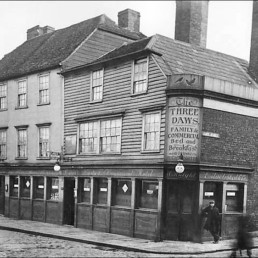The Three Daws
Peer through the murky mist to look for signs of smugglers, pirates or press gangs at the Three Daws.
Choose the Instagram or Facebook button below to open the AR experience.
Double tap anywhere to switch from your front to back cameras.
This experience will open your camera feed. Turn your sound on to enjoy the full experience.
History
Did you know that Gravesend was a popular place for smugglers?
Records show that a public house was located here as early as the 15th century. In fact, the Three Daws is probably the oldest pub in Kent!
It’s rumoured that there were seven staircases and three underground tunnels concealed underneath the pub, enabling sailors to escape press gangs and smugglers to ply their trade.
Despite its wooden construction, the Three Dawes escaped the many fires which destroyed much of Gravesend.
Its first name was the ‘Cornish Chough’ (1488-1707), then it became the ‘Three Cornish Choughs’ (1708-1778). Choughs are a bird related to jackdaws and no doubt sometime in the past were misidentified as jackdaws, which was corrupted to the now familiar name ‘daws’.
Adjacent to the pub is the original landing place, or hythe, used by pilgrims crossing the river on their way to Canterbury Cathedral. The Cornish Choughs are associated with Saint Thomas Becket and would have been familiar to those making a pilgrimage to his resting place at Canterbury (three Cornish Choughs appear in the arms of Canterbury City).
A reference to it as the Three Daws appears in the Gravesend Register of 1667.

